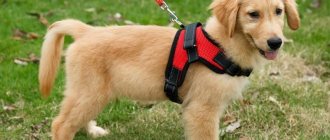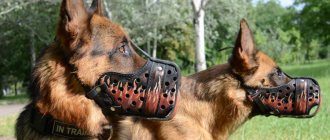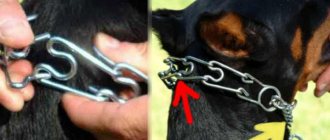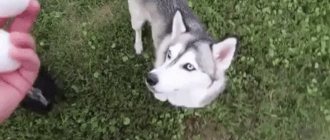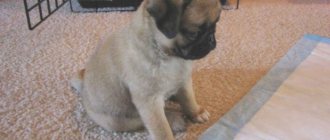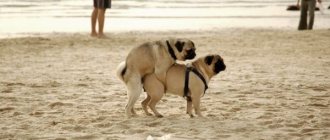Puppy training
Accustoming your baby to walking accessories should take place in several stages:
- Adaptation. Before starting training, the owner needs to prepare by choosing the right type of equipment. The puppy should “get to know” her by sniffing her thoroughly. He should not be allowed to play with accessories. This habit will become distracting to the puppy during training.
- Preparatory stage. First, the baby is accustomed to the collar. To do this, call the puppy, put a collar on him and try to distract the dog’s attention from him (with a new toy or treat). It is not allowed to remove the ammunition when the pet is trying to get rid of it. When the puppy forgets about his accessory, you should carefully remove it. If the collar stops causing concern to the dog, you can move on to the next stage.
The collar should not be tightened too tightly. A loose accessory also carries danger. 2 fingers of the owner should be placed between it and the pet’s neck.
- House training. Before going outside, the puppy must learn to walk on a leash in a familiar environment (within the house). You can start by attaching a short rope to the collar to pull your pet. When this lesson is mastered, the rope should be replaced with a leash (no longer than 2 meters). During training, the puppy must not be left unattended to avoid injury. The owner must show the pet what this item is for. To do this, you should pick it up and follow the puppy around the house. If the pet does not resist, it is necessary to reward it with its favorite treat. This will serve as motivation for further learning.
- Outdoor training. You can take your baby outside after mastering the previous stages. The owner's task is to hone the pet's ability to walk next to him. The puppy should walk behind the person. If he runs away or pulls the owner in his direction, the trainer must immediately stop and call the animal. You can continue moving when the puppy approaches. No need to pull on the leash! This action will only embitter and demotivate the baby.
If you correctly approach training a puppy to walk side by side on a leash, after a month the owner will become the owner of an obedient and well-mannered dog.
Possible problems and their solutions
If the owner has tried everything, but the dog does not want to follow commands and does not obey, then you need to look at your behavior.
The following problems may occur:
- The owner repeated one command many times. If your pet wants to come only the fifth time, then you shouldn’t give him a treat. He will think that the order must be submitted many times, so he will not approach the first one.
- Fastening to a leash. It is prohibited to perform this action immediately after executing the order. First you need to call the animal, and after some time fasten the leash.
- Wrong intonation. Many owners cannot develop a commanding tone so that their pet will obey. Don't break down or yell at the puppy. Relationships with a dog should be built on mutual understanding. It is necessary to work on intonation so that the pet follows commands.
- You should not punish after following an order. If the animal does not approach the first time, then it is forbidden to scold it. The dog develops a misconception about the command. You should not get angry, otherwise this will lead to your pet stopping obeying.
If these mistakes are avoided, then after some time the owner will be able to walk the dog without a leash. She will listen to him, understand and love him. It is best to follow all recommendations to avoid mistakes.
Training an adult animal
The stages of leash training an adult dog are no different from training a puppy. It is important to follow their sequence in both cases.
The leash for an adult pet should be long (7-8 meters). The animal's freedom is not sharply limited, which has a beneficial effect on its training. The motivation system evokes positive emotions in the pet. The training should be relaxed and should not last more than 30 minutes.
If you provide comfortable training conditions and act step by step, the dog will master the basics of training in the shortest possible time.
Puppies instinctively do not know how to walk on a leash.
Even thoroughbreds. They need to be taught this. Since a small puppy is much easier to train than a strong teenager or adult, you need to start training immediately as soon as the puppy appears in the house.
When training with a puppy, remember that the leash should always be loose and not taut!
And if you allow the puppy to pull you, the puppy will resist more and more, trying to dominate you.
Basic Rules
There are basic rules that the owner can follow to facilitate the dog’s training process:
- Acquaintance with accessories for a walk should be carried out on your territory (within the animal’s place of residence).
- Household members and strangers should not be nearby during training. This reduces the pet's concentration.
- It is better to conduct lessons 2 hours after a meal (preferably after a walk), which will increase the dog’s interest in the treat and increase his motivation).
- Training should be regular, the stages of training should be consistent.
- Ammunition should be selected correctly. It is unacceptable to purchase a product with a strong odor or the wrong size.
It is forbidden:
- Show aggression and use physical force to punish your pet. This will only embitter him, the dog will begin to resist.
- Jump from stage to stage in the training process. The animal will not understand what is required of it.
Treat training method
Teaching the command “Near!” The “food guidance” method is used for large dogs that do not respond to a jerk of the leash, as well as pets that will have to bypass the trainer in accordance with the standard. For motivation with treats to work, your pet must start training hungry.
The essence of the technique is that the owner, after showing the dog a treat and holding it in his palm, moves his hand in the direction where the pet should approach. A hungry pet will closely monitor the tasty treat and follow it, thereby taking the correct position near its mentor’s leg. We can say that the dog is “targeted.”
As a reward for good execution of the command “Near!” Give your dog treats periodically. To begin with, it is enough for the pet to take a place at your foot on command.
The next stage of learning is moving forward. The dog will go for the treasured piece and will gradually learn to walk in a straight line with you. Try to increase the intervals between tasty rewards. Next, you can hone the art of turns, changing the pace of movement and other maneuvers.
Professional trainers usually start teaching the dog the “Here!” command. using food lures, then move on to standard training with a leash. Subsequently, the techniques can be alternated, taking into account the animal’s mood.
Practicing the 'nearby' command
This command is the most important. With its help, the owner can protect his pet from cars and fights with stray animals.
Training rules:
- The training is carried out during a walk, when the pet is not busy with anything and is not distracted by foreign objects.
- The owner says in a calm voice “nearby” and quietly pulls the leash towards himself. If your pet approaches, you should reward him with a kind word and your favorite treat.
- If the animal resists and is directed in the opposite direction, the person should pull the equipment towards himself with a sharp (but not strong) jerk, leaving the dog no choice. When the pet approaches, it must be treated.
- To train adults, a 'strict collar' is used. Its peculiarity is the spikes on the inside, which cause pain when jerking.
Training should take place in a relaxed, calm environment. When conducting them, you should pay attention to other people's animals. Not every owner will be able to control the actions of their pet. To avoid a fight, you need to be especially careful.
The importance of freedom
It is important for any dog to get daily exercise, engage in active games in the fresh air, run, contact other animals, and jump. This is required so that the dog develops correctly, builds up muscles, and puts stress on the limbs. In addition, it is important for the animal to splash out energy, otherwise the dog will behave extremely actively in the apartment. This can lead to damaged furniture, objects, and loud barking for no particular reason.
By allowing the animal to walk without a leash, owners often experience problems with the pet running away without responding to the owner’s commands, and much worse if the dog begins to attack other walking animals.
To avoid such difficulties, you will need to start raising the puppy from the very first days of his stay in the apartment. It is important for the owner to demonstrate to the pet that it is the person who is in charge in their relationship. The owner should not turn into a servant for the dog who constantly fulfills its whims.
how to train a dog to a chain and a kennel
Walking without a leash
This type of walk is available only to a well-mannered animal who knows the commands “come to me”, “nearby”.
Walking your pet without a leash should only be done in familiar territory. It is unacceptable to walk him without equipment in a crowded place.
At this stage, the owner’s task is to be able to fasten the strap to the dog’s collar at any time. During training, your pet should not be distracted by anything. The owner pronounces the command “come to me” in a calm but stern voice. When the dog approaches, a leash is attached to his collar. If the dog does not resist, a treat awaits him. Over time, this process will not cause negative emotions in her.
How to train a dog to walk next to you without a leash
Subsequently, the “Near” command for the dog can be complicated. To do this, you need to teach the animal to move near its owner without ammunition.
To consolidate the skill, increase the distance between you and your pet to 5 meters or more. If the animal is closer, it will be enough for him to simply hear a familiar phrase, and if not, call him closer using “Come to me” and only then give the main order.
The problem is that without the use of ammunition, the skill gradually deteriorates. For this reason, you need to regularly practice both options.
Choosing ammunition
For high-quality and fast training, you need to choose the right equipment. Accessories should be comfortable and suitable for the dog in size and purpose.
Collar
The collar should fit the dog in size without causing discomfort in the form of squeezing the neck. Types of collars:
- Everyday. Designed for daily walks. They are the most popular and are made mainly from leather. Their main conditions are strength and reliability. You should pay attention to the convenience of attaching such a collar to the leash.
- Exhibition. Designed in the form of a chain-noose, they have a spectacular appearance. Used for dog shows.
- Training. A collar in the form of a noose tightens the loop when the animal tries to pull the leash; a “strict collar” with spikes on the inside causes discomfort to the dog when tugging. Electric collars apply current or ultrasound to the pet if it misbehaves.
- Decorative. Serve for beauty. Used for small breed dogs kept at home.
The collar should not fit too tightly. 2 human fingers should fit between the pet's neck and the accessory. For puppies, it is advisable to purchase a collar with adjustable length. The noose is selected according to the size of the puppy’s head, the collar - according to the circumference of the neck.
Leash
The walking item must be the right size for your pet. Kinds:
- Short (up to 2 meters). Suitable for puppies and small breed dogs.
- Long (5-7 meters). Designed for adult dogs.
- Roulette. Designed for pets who have mastered the basics of parenting. It is impossible to train a dog with its help.
When choosing a leash, you should pay attention to the material. It must be durable. The optimal belt width is 2 cm.
To accustom a dog to a collar and leash, the owner will have to be patient. If you follow all the tips and recommendations, the training process will be comfortable for both the pet and its person.
Tips from dog handlers
The dog’s ability to master the command “Near!” largely depends on how concentrated it is. Practice the skill for no longer than 10 minutes a day at the initial stage. Subsequently, you can increase the total time of classes, but in any case it should not exceed 20 minutes. It is advisable that each workout last 2-3 minutes. Accordingly, you will be able to train 5-6 times a day.
Study the character traits and preferences of your dog. Sometimes a more effective solution is to replace the reward with a treat with a reward in the form of a favorite toy, which is great for attracting your pet's attention.
Before starting training, the dog must get some exercise. Start your classes in quiet, deserted places, gradually moving to areas with distractions.
To teach the command “Near!” adult large dogs are allowed to use parfors. A metal collar with curved spikes operates on the principle of a noose. When choosing a strict collar, you need to take into account the breed, size and type of coat of the dog.
Don’t forget to reinforce the dog’s acquired skill of walking next to you. Command your pet “Here!” when you approach the track. During long walks, practice executing the command in various variations: with stops, turns, and changes in speed. Regular dog training will be the key to success!
Basic mistakes in the learning process
If you want to teach your pet the “near” command, you should avoid mistakes such as:
- a jerk and only then a command;
- walks with a constantly tight leash;
- pronouncing commands in a menacing tone;
- practicing a command without a leash without prior training with a leash.
Training a dog is a lot of work.
Training your dog from a young age will help you avoid problems with your pet in the future. You should not accustom an animal to aggression; frightening and hitting is also prohibited, as this will have a negative impact on the character of your four-legged friend. Consistency and adequacy will help the owner figure out how to teach the dog to walk next to him.

